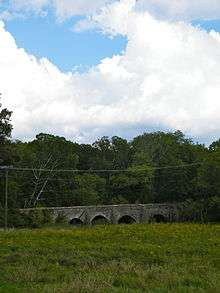Goose Creek (Potomac River tributary)
Goose Creek is a 53.9-mile-long (86.7 km)[1] tributary of the Potomac River in Fauquier and Loudoun counties in northern Virginia. It comprises the principal drainage system for the Loudoun Valley.
| Goose Creek | |
|---|---|
 Goose Creek Bridge | |
| Location | |
| Country | United States |
| State | Virginia |
| Region | Loudoun County, Fauquier County |
| Physical characteristics | |
| Source | |
| • location | Linden |
| • coordinates | 38.9148335°N 78.0702756°W |
| • elevation | 1,040 ft (320 m) |
| Mouth | Potomac River |
• location | Lansdowne |
• coordinates | 39.1012177°N 77.4772109°W |
• elevation | 187 ft (57 m) |
| Length | 55 mi (89 km) |
Course
Goose Creek rises at Manassas Gap on the Blue Ridge near Linden. The creek initially flows eastward down the mountain, falling 600 feet (180 m) in its first 10 miles (16 km). At Delaplane the creek levels out and turns in a northeasterly direction for another 10 miles, whereupon it passes under U.S. Route 50 and enters Loudoun County. Once in Loudoun, the creek continues in a northeastward direction for 15 miles (24 km) to the western foot of Catoctin Mountain, where it turns to the north briefly, before reaching the confluence of the North Fork and then turning to the east and cutting through a gap in the mountain. On the east side of the mountain the creek again turns to northeast, joining with the Little River. The creek flows for 15 miles (24 km) through central Loudoun County, reaching the Potomac just east of Leesburg and south of Harrison Island. Goose Creek is partially dammed north of State Route 267. The dam may be portaged through the woods on the eastern shore.
North Fork
The North Fork of Goose Creek rises at the east end of Sleeter Lake in Round Hill and flows 13.3 miles (21.4 km)[1] in a southeastward direction, joining with the main branch in the water gap of the Catoctin Mountain.
Conservation
The Goose Creek Association works to protect the watershed and landscape.[2]
Map of Goose Creek
In 1849, construction began on a system of locks and dams to render the creek navigable up to three large mills in the Loudoun Valley on the Little River, North Fork and main creek bed. Across the Potomac from the mouth of a creek, a special lock on the C&O Canal was constructed to allow canal boats from Goose Creek to enter the canal. By 1845, the Goose Creek and Little River Navigation Company canal system had been completed on Goose Creek to Ball's (Evergreen) Mill, 12 miles (19 km) upstream from the mouth. Due to financial concerns it was decided that the canal would not be built any further upstream. Though the lower portion of the canal saw significant usage, only one boat was ever known to have traveled the whole stretch, and by 1857 the canal was put out of business by the completion of the Alexandria, Loudoun and Hampshire Railroad to Leesburg. Most of the locks and dams were destroyed by the Union Army during the Civil War.
Goose Creek Bridge on the Ashby's Gap Turnpike was the site of a Civil War battle in the Loudoun Valley during the Gettysburg Campaign in 1863. (See Battle of Upperville#Goose Creek for details.) The bridge was built between 1801 and 1803 and is the longest remaining stone turnpike bridge in the state of Virginia.
Tributaries

Tributaries are listed in order from the source of Goose Creek to its mouth.
- Mitchell's Branch
- Bolling Branch
- Gap Run
- Panther Skin Creek
- Cromwell's Run
- Wancopin Creek
- North Fork Goose Creek
- Jacks' Run
- Crooked Run
- Beaverdam Creek
- Big Branch
- Little River
- Tan Branch
- Black Branch
- Beaver Dam Creek
- Sycolin Creek
- Tuscarora Creek
- Dry Mill Branch
- Cattail Branch
Variant names
According to the Geographic Names Information System, Goose Creek has been known by the following names throughout its history:
- Cokongoloto
- Cokongoloto Anglice
- Goes Creek
- Goes Flug
- Gohongarestaw
- Gooscreek
- Goose River
- Lee's Creek
- Tiber River
See also
References
- U.S. Geological Survey. National Hydrography Dataset high-resolution flowline data. The National Map Archived 2012-04-05 at WebCite, accessed August 15, 2011
- "Janet G. Whitehouse, conservationist, historic preservationist". Washington Post. 16 January 2014.
External links
- U.S. Geological Survey Geographic Names Information System: Goose Creek
- Historic American Engineering Record (HAER) No. VA-39, "Goose Creek & Little River Navigation, Double Lock, Mouth of Goose Creek at Potomac River, Leesburg, Loudoun County, VA", 3 measured drawings, 2 data pages